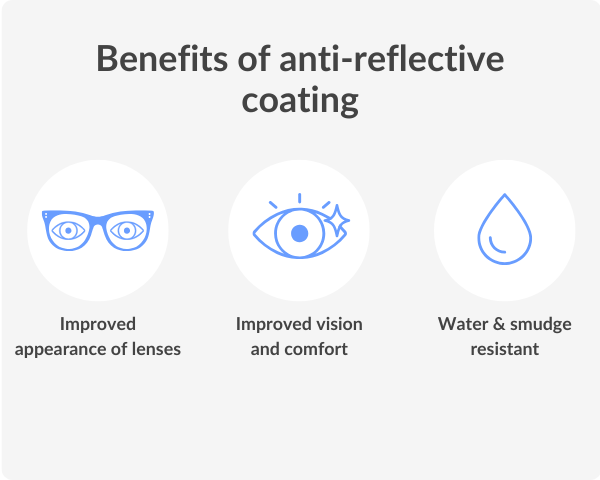How Can I Make My Glasses Anti-Reflective?

Reviewed by
Maria Horan FBDO
As we’re all aware, the main function of glasses is to allow us to enjoy a clear, sharp field of vision, and therefore live life in greater comfort.
However, if you wear glasses regularly, you’re probably familiar with the annoying reflections and glare from lenses.
Modern lens technology has found smart solutions to fix this, and anti-reflective coating is one of them. Here, we’ll explain how it works and why it might be the perfect upgrade for your eyeglasses.
What is glare and how does it affect your eyesight?
Do you ever feel discomfort when looking directly at sources of light through your glasses? This could be due to glare.
Glare is defined as a strong, dazzling light. Although it often comes directly from a light source, it can also happen when light is reflected off an object, such as glass, water and certain metals.
Due to the glare we experience from highly reflective surfaces, viewing these objects closer to a light source becomes difficult.
What are anti-reflective glasses?
There are several types of coatings you can add to your eyeglass lenses to improve your viewing experience. These include impact resistance, hydrophobic, UV and blue light protection, and, of course, anti-reflective coatings.
Also known as anti-glare lenses, anti-reflective (AR) coatings reduce reflections on the outer surface of lenses by allowing more light to pass through them.
Have you ever been unable to see a person’s eyes due to the reflection on their glasses? These reflections are an aesthetic concern for some, especially in photos or video calls. AR coatings help eliminate these unwanted reflections, ensuring your eyes remain visible.
Beyond aesthetics, AR coatings also improve visual clarity. By allowing more light to pass through instead of bouncing it off, the halos that form around bright lights are removed from view, improving visual acuity as a result.

This can reduce eye strain in various conditions while making everyday activities more comfortable, such as driving at night and using digital devices.
While some retailers use the term “anti-glare coating,” it’s important to note that the correct terminology is “anti-reflective coating.” If you’re looking for a lens technology that only reduces glare, polarized lenses are the best solution, although they are only available for sunglasses.
How does an anti-reflective coating work?
AR coatings are made of layers of metal oxides. Simply put, anti-reflective coating cancels out the light reflected on the surface of the lenses and allows more light to pass through them and reach your eyes.
The more light that reaches your eyes, the more clearly you can see. This is all achieved by a fairly complex scientific process called the optical interference model.

Basically, the layers of the anti-reflective coating work together to introduce “destructive” light waves, which, as their name suggests, destroy the reflection on the lenses.
Uncoated lenses allow about 92% of light to pass through them. Anti-reflective coating increases that number to 99%, giving the wearer greater visual acuity.
Caring for glasses with anti-reflective lenses
Contrary to what you may think, an anti-reflective coating can make your glasses easier to clean and care for. Most AR coatings give the lens surface a hydrophobic finish, which repels water and dirt, so the lenses don’t smudge so easily.
That said, you may have to clean them more frequently as dust is more visible on them. Like with any glasses, always use a microfibre cloth to clean instead of a t-shirt, tissue, or other materials that may cause tiny abrasions.
It’s also useful to wet the lenses beforehand to further protect them from the risk of friction-induced scratches.
Ask your optician to recommend which cleaning products can be safely used to clean your anti-reflective glasses. The harsh chemicals in some products can damage this type of coating.
Benefits of anti-reflective coatings
The most noticeable benefit of AR coatings is the improved appearance of the lenses. Without reflections, the wearer’s eyes are more visible, making conversation and eye contact in general easier.
For the wearer, the absence of reflections on their lenses is less distracting, especially in situations such as driving at night, working in a brightly lit environment, or in front of digital screens. As a result, your eyes are put under less strain.
AR lens coatings also improve visual acuity, meaning your vision will be sharper, thanks to the extra light getting through to your eyes.

This coating is particularly useful on high-index lenses, as these can reflect up to 50% more light than other lenses. This makes an AR coating almost essential for high-index prescription lens wearers.
When it comes to sunglasses, the dark lens tint generally negates the need for an AR coating on the outside of the lenses. However, it can still be applied on the inside of the lenses for greater comfort when the sun is behind you.
DID YOU KNOW?
Every anti-reflective coating gives the lenses it’s applied to a very subtle tint. This tint is most often either green, brown, or yellow.
Anti-reflective vs polarized lenses
Both AR coatings and polarized lenses greatly reduce glare, but the way they do it and the situations they serve best may differ.
As you now know, AR coatings allow more light to pass through the lens, reducing distractions from glare, improving visual clarity, and eye contact. They are helpful for everyday eyeglasses, and particularly beneficial for driving at night or digital device usage.
Polarized lenses, on the other hand, block horizontal light waves, which are responsible for creating glare from surfaces like water, road, and snow, providing the wearer with sharper vision. Best used in outdoor activities, these lenses are typically heavily tinted, making them unsuitable for regular eyeglasses.

If you spend a lot of time outdoors and participate in activities such as driving, fishing and skiing, polarized glasses may be a valuable addition for you. But if adding an extra coat of benefits to your regular prescription glasses is what you’re looking for, AR coating will be the best choice.
Either way, both options offer the valuable benefits of anti-glare, improving your visual comfort and clarity based on your lifestyle needs.
How can I make my glasses anti-reflective?
As is usually the case when it comes to eyewear choices, your own vision requirements and lifestyle will dictate what the best option for you is.
If, after reading this article, you believe anti-reflective lens coating is worth the investment, here’s how you can get your anti-glare glasses:
- Explore our wide range of eyewear and find your favorite pair. Feel free to experiment with our Virtual Try-On Tool to see what frames look like on you before you buy.
- When adding your new frames to the cart, click the “Choose Lenses” option.
- Choose the type of lens you need, such as single vision, progressive or plano (non-prescription). Add your prescription details if you need lenses with corrective power.
- Select a “Lens Package” with anti-reflective coating. All our lens packages aside from our free 1.5 index lenses include this.
- Choose any additional add-ons and proceed to checkout.
And that’s, you’re anti-glare glasses will arrive in no time!
If you’re still unsure if AR coating is right for you, feel free to explore our Lens Hub or reach out to one of our opticians– they’re here to answer any questions and can help you make the best choice for your needs.
Related articles



Related articles











































